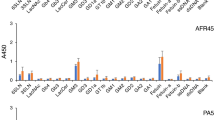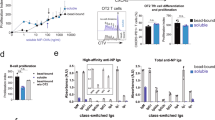Abstract
IT is well established that addition of anti-immunoglobulin (anti-Ig) to lymphocytes expressing Ig receptors produces ‘capping’ followed by endocytosis or ‘sloughing’ of the membrane Ig, the expression of which is greatly diminished until resynthesis occurs1. Another property of anti-Ig in some species, notably the rabbit, is blastogenic activation of lymphocytes2. It is known that for the activation of lymphocytes by plant mitogens, the mitogenic substance must persist on the cell membrane for several hours before irreversible activation of the cell occurs3. Similarly, the activation of rabbit lymphocytes by antiserum to allotypic Ig determinants is largely inhibited if the Ig expressing the target allotype is added within a few hours4. Thus there is an apparent conflict between these two phenomena, one of which centres around the rapid removal of membrane Ig, the other requiring the persistence of anti-Ig for longer periods. Accordingly, experiments were designed to test the degree of retention of anti-Ig and the re-expression of membrane Ig on the surface of lymphocytes treated with anti-Ig sera and retained in tissue culture for several days.
This is a preview of subscription content, access via your institution
Access options
Subscribe to this journal
Receive 51 print issues and online access
$199.00 per year
only $3.90 per issue
Buy this article
- Purchase on Springer Link
- Instant access to full article PDF
Prices may be subject to local taxes which are calculated during checkout
Similar content being viewed by others
References
Taylor, R. B., Duffus, W. P. H., Raff, M. C., and de Petris, S., Nature new Biol., 233, 225–229 (1971).
Sell, S., and Gell, P. G. H., J. exp. Med., 122, 423–440 (1965).
Kay, J. E., Expl Cell Rex., 58, 185–188 (1969).
Sell, S., Lowe, J. A., and Cell, P. G. H., J. Immun., 108, 674–682 (1972).
Nash, A. A., J. Immun. Meth., 12, 149–161 (1976).
Hallberg, T., Haegert, D., Clein, G. P., Coombs, R. R. A., Feinstein, A., and Gurner, B. W., J. Immun. Meth., 4, 317–332 (1974).
Escajadillo, C., Heller, E. D., Wilson, A. B., Gurner, B. W., and Coombs, R. R. A., J. Immun. Meth., 4, 333–348 (1974).
Engers, H. D., and Unanue, E. R., J. Immun., 110, 465–475 (1973).
Loor, F., Forni, L., and Pernis, B., Eur. J. Immun., 2, 203–212 (1972).
Banks, K. L., and McGuire, T. C., J. Immun., 114, 1307–1313 (1975).
Unanue, E. R., Cerottini, J-C., and Bedford, M., Nature, 222, 1193–1195 (1969).
Humphrey, J. H., Antibiot. Chemother., 15, 7–23 (1969).
Ault, K. A., Unanue, E. R., Katz, D. H., and Benacerraf, B., Proc. natn. Acad. Sci. U.S.A., 71, 3111–3114 (1974).
Unanue, E. R., and Karnovsky, M. J., Transplant. Rev., 14, 184–210 (1973).
Ling, N. R., and Kay, J. E., Lymphocyte Stimulation (North Holland/American Elsevier, Amsterdam, 1975).
Author information
Authors and Affiliations
Rights and permissions
About this article
Cite this article
NASH, A., LING, N. Persistence of anti-immunoglobulin on the lymphocyte surface. Nature 264, 255–256 (1976). https://doi.org/10.1038/264255a0
Received:
Accepted:
Issue Date:
DOI: https://doi.org/10.1038/264255a0
Comments
By submitting a comment you agree to abide by our Terms and Community Guidelines. If you find something abusive or that does not comply with our terms or guidelines please flag it as inappropriate.



